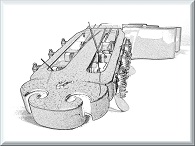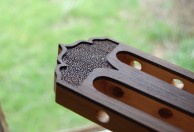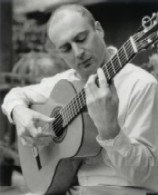Welcome to one of the most active flamenco sites on the Internet. Guests can read most posts but if you want to participate click here to register.
This site is dedicated to the memory of Paco de Lucía, Ron Mitchell, Guy Williams, Linda Elvira, Philip John Lee, Craig Eros, Ben Woods, David Serva and Tom Blackshear who went ahead of us.
We receive 12,200 visitors a month from 200 countries and 1.7 million page impressions a year. To advertise on this site please contact us.
|

|
|
R.E. Brune 1893 Guitar Restoration
|
You are logged in as Guest
|
|
Users viewing this topic: none
|
|
Login  | |
|

   
Andy Culpepper
Posts: 3023
Joined: Mar. 30 2009
From: NY, USA

|
 RE: R.E. Brune 1893 Guitar Restoration (in reply to RTC) RE: R.E. Brune 1893 Guitar Restoration (in reply to RTC)
|
|
|
Cool cool cool. Brune is still in great shape playing-wise.
I would say that the entire evolution of the guitar has been driven players, in conjunction with, but mostly likely to a greater extent than builders.
So the "flamenco guitar" most likely began to be differentiated in the first couple of decades of the 20th century, although it might not have been labeled as such until some time later. This would correspond with the rising popularity and development of flamenco music, with guitarists like Ramon Montoya, Miguel Borrull and Javier Molina looking for master quality instruments that would be the perfect tools of their trade. Santos seems to have been the biggest name at the cusp of this transition.
One interesting thing to study would be the history of the golpe and the golpeador. Ramon Montoya and others seem to have been using golpes in the earliest recorded examples of their playing but I've never heard definitively how far back the technique goes. And I'm sure Santos was making cypress guitars with built-on maple tap plates back then, which pretty definitively shows that the guitars were meant to be used for flamenco. Which, after all, is really the definition of a "flamenco guitar", notwithstanding tonal differences that were also clearly being developed. 
_____________________________
Andy Culpepper, luthier
http://www.andyculpepper.com
|
|
|
|
REPORT THIS POST AS INAPPROPRIATE |
Date Nov. 15 2012 21:38:16
 |
|

   
Ricardo
Posts: 14822
Joined: Dec. 14 2004
From: Washington DC

|
 RE: R.E. Brune 1893 Guitar Restoration (in reply to Andy Culpepper) RE: R.E. Brune 1893 Guitar Restoration (in reply to Andy Culpepper)
|
|
|
quote:
And I'm sure Santos was making cypress guitars with built-on maple tap plates back then, which pretty definitively shows that the guitars were meant to be used for flamenco. Which, after all, is really the definition of a "flamenco guitar", notwithstanding tonal differences that were also clearly being developed.
my guess is all the guitars used by flamencos were destroyed by golpes until they starting putting wood tap plates....and they probably did that over top of damage at first...just my guess. I remember seeing a maple M. Ramirez from 1912 that had tap plate on it. guitar salon considered it a classical but it was obvious SOMEONE was using it for flamenco. Ramirez III says in his book he had a cypress torres 1862 that he implies was probably the type flamenco players gravitated to. He thinks that cypress was thought to be good luck vs the dark wood guitars that might be bad luck (gypsy superstitions). So his grandfather made a guitar (Jose I) for professionals and called it "tablao" guitar. the one he had in collection was 1918, maple back and sides... a bit bigger size but skinnier. M. Ramirez his brother made the same type of guitar too (he had 1900 version in collection), but decided to innovate and cater to the players more, and seems to feel the proper flamenco guitar model is based on his great uncle's design, not his grandfathers, and has one from 1911. (I assume it's either cypress or maple he doesn't say, also no mention of contributions of Santos or Esteso, employed by his Great Uncle). He said his dad (Jose II) was not so stubborn and adapted Manuels model, and he himself (jose III) pretty much sticks to the same general plan, (he liked the idea of tradition, but he innovated freely with classical guitars).
_____________________________
CD's and transcriptions available here:
www.ricardomarlow.com
|
|
|
|
REPORT THIS POST AS INAPPROPRIATE |
Date Nov. 16 2012 15:13:59
 |
|
 New Messages New Messages |
 No New Messages No New Messages |
 Hot Topic w/ New Messages Hot Topic w/ New Messages |
 Hot Topic w/o New Messages Hot Topic w/o New Messages |
 Locked w/ New Messages Locked w/ New Messages |
 Locked w/o New Messages Locked w/o New Messages |
|
 Post New Thread
Post New Thread
 Reply to Message
Reply to Message
 Post New Poll
Post New Poll
 Submit Vote
Submit Vote
 Delete My Own Post
Delete My Own Post
 Delete My Own Thread
Delete My Own Thread
 Rate Posts
Rate Posts
|
|
|
Forum Software powered by ASP Playground Advanced Edition 2.0.5
Copyright © 2000 - 2003 ASPPlayground.NET |
0.0625 secs.
|


 Printable Version
Printable Version
















 New Messages
New Messages No New Messages
No New Messages Hot Topic w/ New Messages
Hot Topic w/ New Messages Hot Topic w/o New Messages
Hot Topic w/o New Messages Locked w/ New Messages
Locked w/ New Messages Locked w/o New Messages
Locked w/o New Messages Post New Thread
Post New Thread